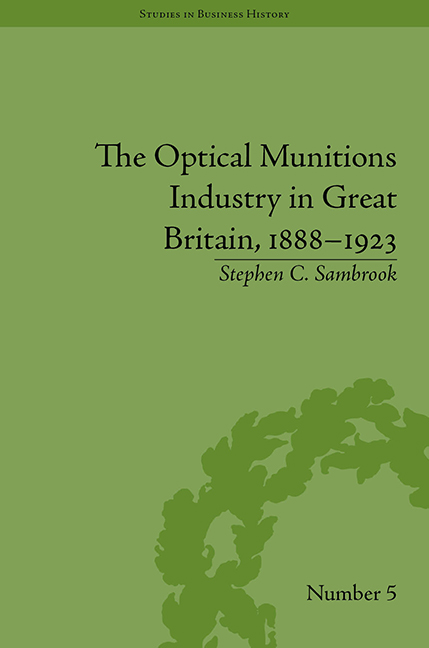Book contents
- Frontmatter
- CONTENTS
- Preface and Acknowledgements
- List of Figures and Tables
- List of Technical Terms
- Introduction
- 1 The Emergence of the Industry, 1888–99
- 2 The Growth in Importance from the Boer War to 1906
- 3 Expansion and Consolidation, 1907–14
- 4 The Impact of War, August 1914 to mid-1915
- 5 Industrial Mobilization: The Ministry of Munitions and its Relationship with the Industry
- 6 The Industry's Wartime, 1915–18
- 7 Industrial Demobilization and Implosion, 1919
- 8 Adaption and Survival, 1919–23
- Conclusion
- Notes
- Works Cited
- Index
8 - Adaption and Survival, 1919–23
- Frontmatter
- CONTENTS
- Preface and Acknowledgements
- List of Figures and Tables
- List of Technical Terms
- Introduction
- 1 The Emergence of the Industry, 1888–99
- 2 The Growth in Importance from the Boer War to 1906
- 3 Expansion and Consolidation, 1907–14
- 4 The Impact of War, August 1914 to mid-1915
- 5 Industrial Mobilization: The Ministry of Munitions and its Relationship with the Industry
- 6 The Industry's Wartime, 1915–18
- 7 Industrial Demobilization and Implosion, 1919
- 8 Adaption and Survival, 1919–23
- Conclusion
- Notes
- Works Cited
- Index
Summary
Having passed through the upheaval of industrial demobilization, the optical munitions makers had to face the longer-term problems of the reversion to peace. The post-war period brought new political attitudes to armaments and the resulting shift to arms limitation and reduction contrasted sharply with the pre-war years, which had been characterized by the willingness of governments to spend heavily on military technologies. Budgets shrank and with demobilization the victorious armies found themselves with a surplus of optical munitions, many of which would not need replacing for a considerable time. This virtually eliminated short- and medium-term demand for land service instruments and for most pre-war producers military optics ceased to be viable business. Matters were different with sophisticated naval instruments such as large rangefinders and submarine periscopes, where demand survived because continuing evolution in related weapons technologies sustained the need for improvements, even though the quantities required were relatively small. These diminished requirements meant that by 1923 only one British company was still substantially involved in complex optical munitions production, and of the other makers mentioned previously, only three continued occasionally to manufacture less complex military optics. Frederick Cheshire's gloomy assessment of the capacity for optical munitions manufacture in 1915 perhaps came closer to the truth in 1923 than when he originally made it; even fewer firms were now involved and the capacity for mass production was far less than before the war.
- Type
- Chapter
- Information
- The Optical Munitions Industry in Great Britain, 1888–1923 , pp. 181 - 204Publisher: Pickering & ChattoFirst published in: 2014



